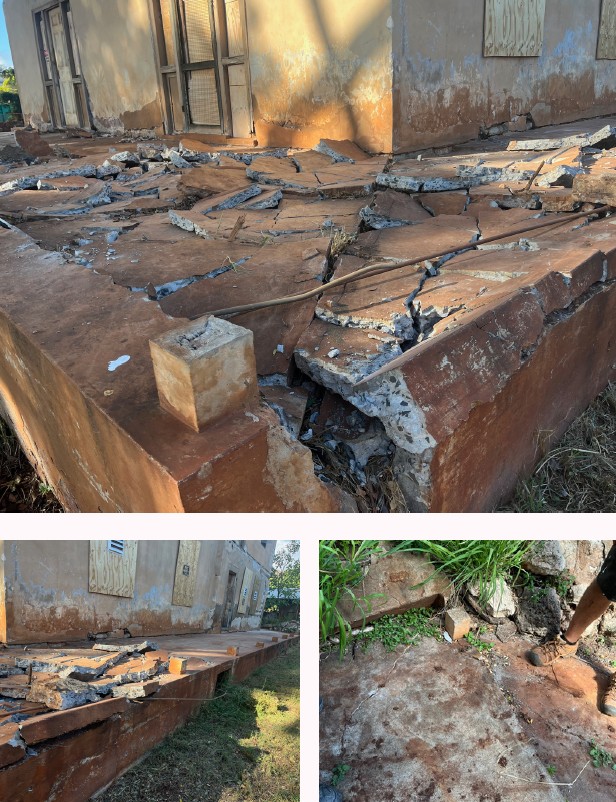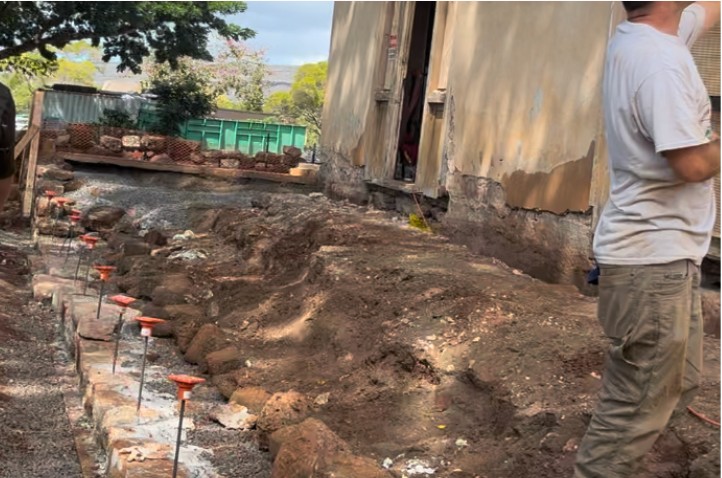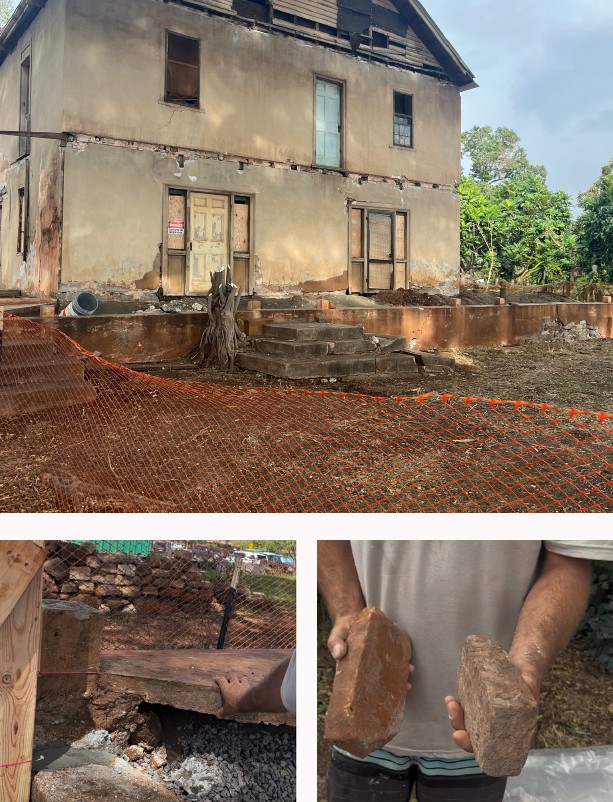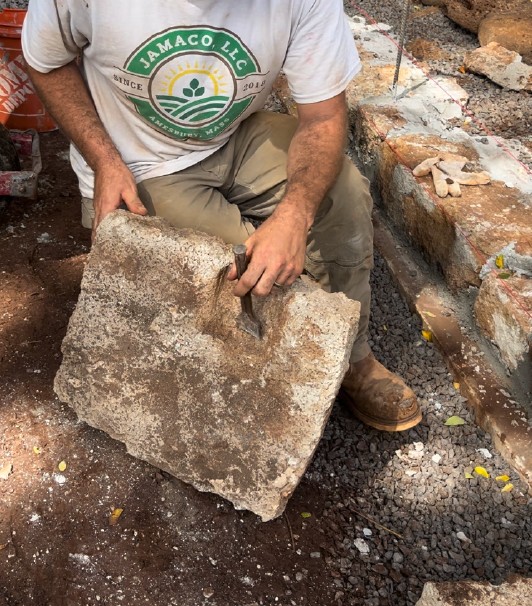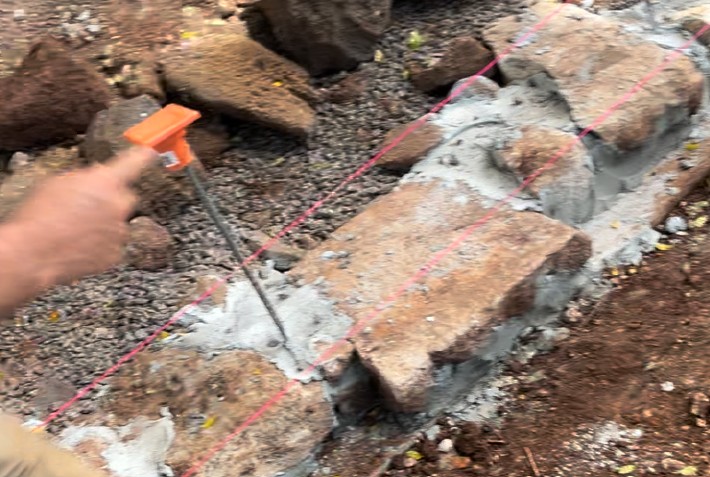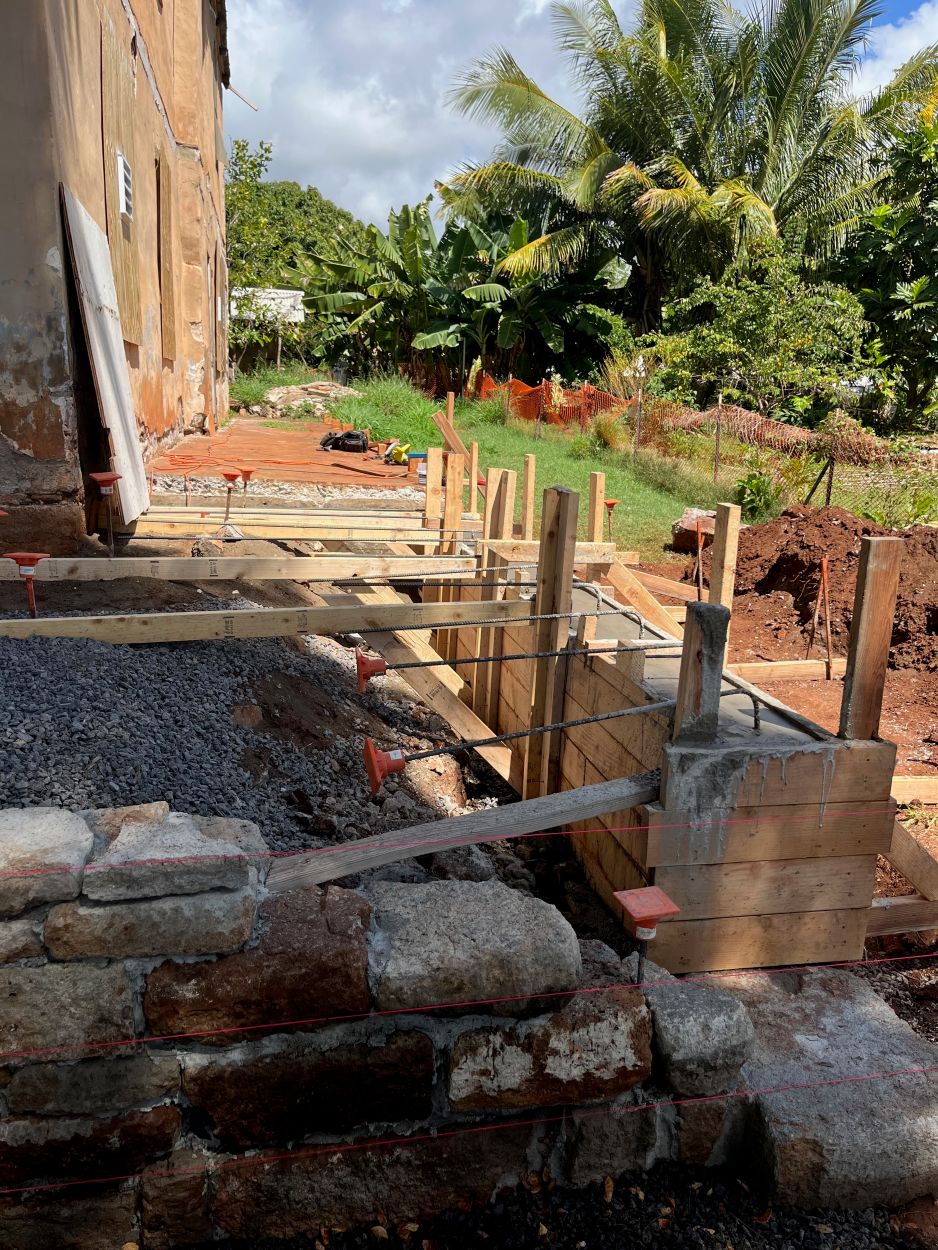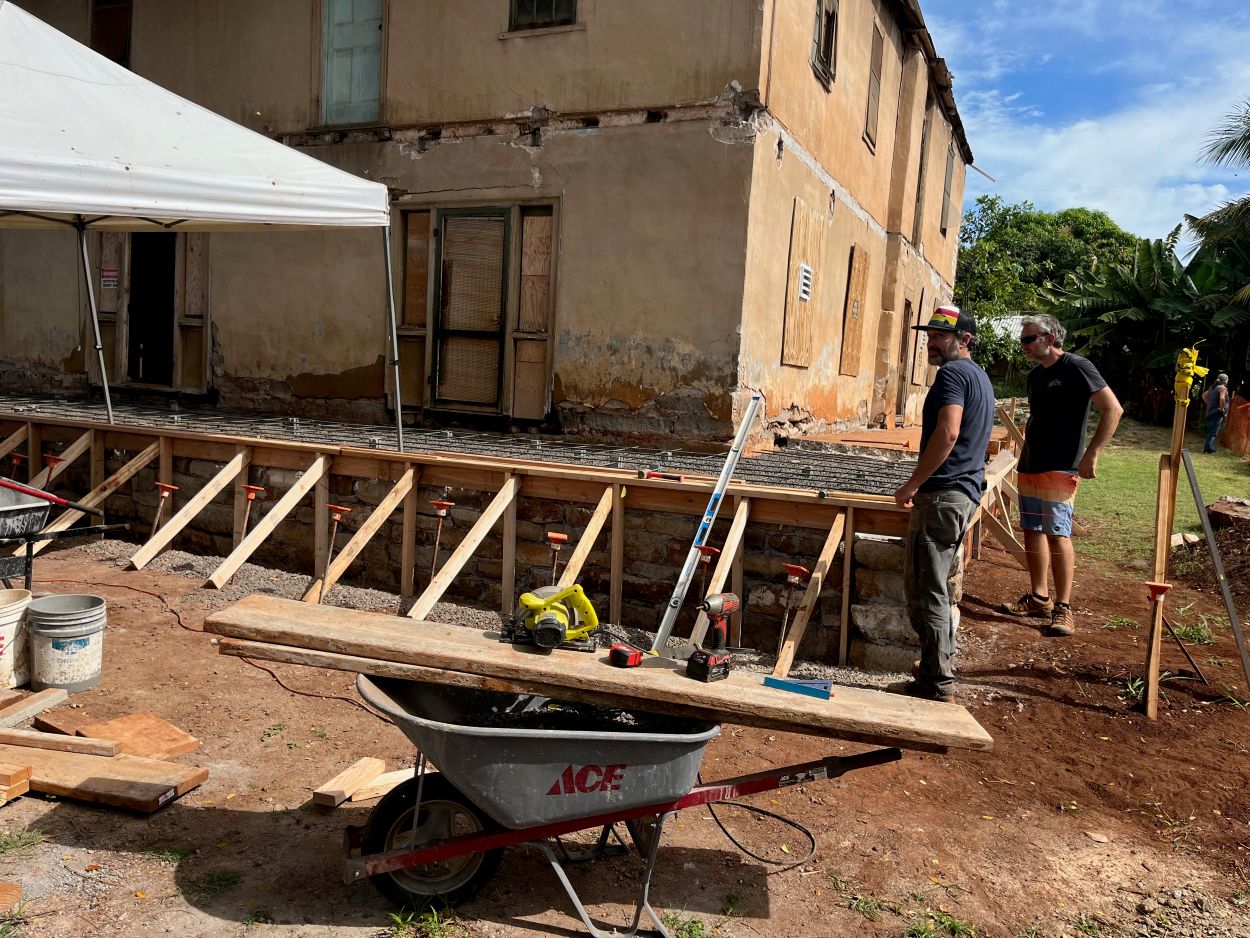
Restoration Work has begun!
Restoration work at the historic Gulick-Rowell House in Waimea, Kaua‘i officially began in March 2025, led by Chara Hoe of Kuleana Contractors. Chara—a native Hawaiian licensed contractor born and raised on Kaua‘i—brings a deep passion for local heritage to the project. The restoration is taking place under the guidance of leading historical architect, Glenn Mason.
Hoe is joined by three New England-based restoration craftsmen experts: Matt Gillard and Hudson Turbity, and Hudson’s brother Brandon who came to lend a hand with the heavy lifting (pictured above). The three immediately recognized familiar New England building techniques adapted with native Hawaiian materials.
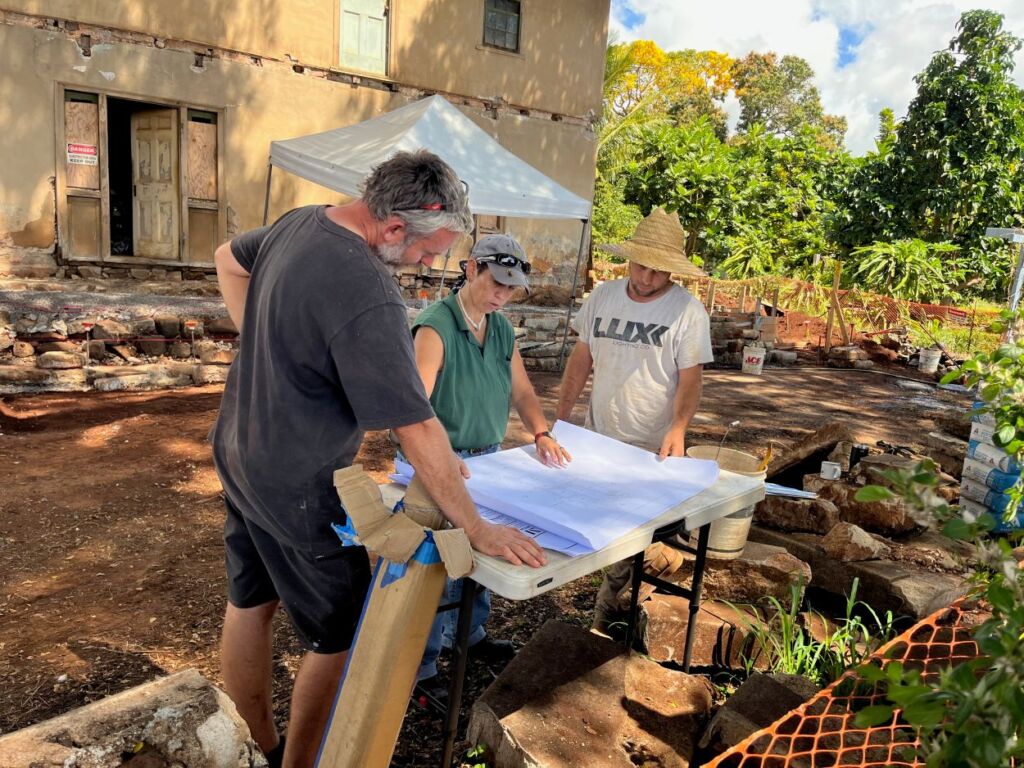 Together, this team has uncovered powerful remnants of the past, such as mysterious chalk markings on a basement support beam—possibly left by prisoners once held in the cellar while awaiting transport to Kalaupapa. While unconfirmed, it is known that the cellar was used as a holding cell at one time for those diagnosed with Hansen’s disease, and the carpenters have shared that the chalk marks have no significance from a carpentry perspective. The discovery has stirred reflection on the building’s layered history.
Together, this team has uncovered powerful remnants of the past, such as mysterious chalk markings on a basement support beam—possibly left by prisoners once held in the cellar while awaiting transport to Kalaupapa. While unconfirmed, it is known that the cellar was used as a holding cell at one time for those diagnosed with Hansen’s disease, and the carpenters have shared that the chalk marks have no significance from a carpentry perspective. The discovery has stirred reflection on the building’s layered history.
Restoration efforts are now focused on rebuilding the concrete deck and two-story lanai. The damaged deck was carefully deconstructed by hand, revealing the use of local rock—pōhaku—that will be re-placed in the rebuilt structure out of deep respect, even if it will later be covered by cement.
These thoughtful decisions—preserving pōhaku, saving original wood from the lanai, and honoring the hidden stories within the walls—are what make this project so special.
The House
Nestled in the heart of Waimea, Kaua‘i, the Gulick-Rowell Mission House is one of the oldest surviving examples of missionary architecture anywhere in the state of Hawai‘i. It was built in 1828 by Reverend Peter Gulick and his wife Fanny who arrived to Waimea, Kaua’i from Boston, Massachusetts, to work at the missionary station there. The Gulicks immediately set forth to build a traditional New England-style house that they were used to, with solid walls and windows. Constructed with coral bricks for the foundation and walls, floated ashore and hauled by oxen—some even lent by the last Queen of Kaua‘i, Deborah Kapule Kekaihaʻakūlou—the house is a rare and tangible remnant of a pivotal chapter in Hawaiian history.
After being vacated by the Gulicks in 1835 when they were transferred to the missionary station in Kōloa, the house remained empty and fell into disrepair until 1846 when it was occupied by Reverend George Rowell and his wife Malvina, who made extensive repairs and expansions. George Rowell was an accomplished carpenter, and built two churches in Waimea during his term there.
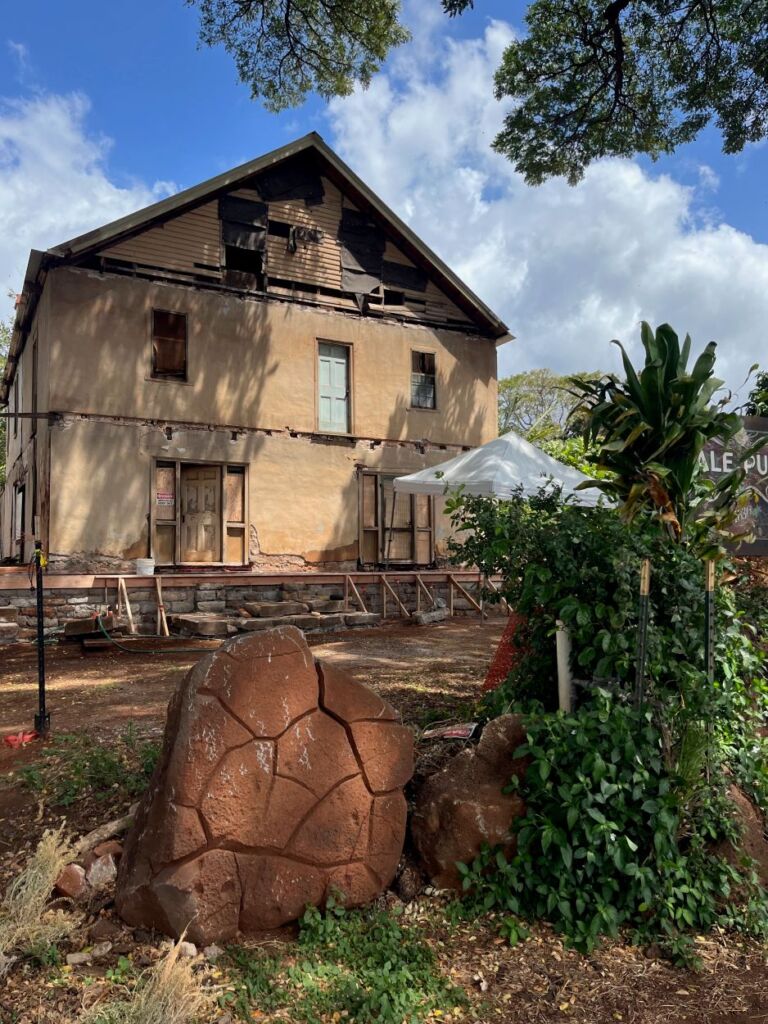 The Rowells remained at Waimea in the home until 1884. After that the home was occupied by various townspeople, including the postmaster (there are remnants of post boxes in the main room), the sheriff, who reportedly used the basement as a jail, and various schoolteachers and church members. The coral bricks are highly unusual and represent a distinct architectural period in Hawaiian history. It would have been heavy and difficult labor for the native Hawaiians who were employed to quarry these bricks.
The Rowells remained at Waimea in the home until 1884. After that the home was occupied by various townspeople, including the postmaster (there are remnants of post boxes in the main room), the sheriff, who reportedly used the basement as a jail, and various schoolteachers and church members. The coral bricks are highly unusual and represent a distinct architectural period in Hawaiian history. It would have been heavy and difficult labor for the native Hawaiians who were employed to quarry these bricks.
The house has been on the National and State Historic Register since 1972. The site had been unoccupied since 2003. In 2006, Historic Hawai’i Foundation placed Gulick-Rowell House on the list of Hawaii’s Most Endangered Historic Places.
The Need
Decades of neglect had led to steady deterioration and an immediate need to safeguard the property. A complete assessment of the entire property was needed to understand the scope of the project and come up with a comprehensive Preservation Plan. Securing the site with fencing and treating the structure for termites were among the first tasks to complete. The historic significance of the property dictates that all work must be done in accordance with the Secretary of the Interior’s Standards for the Treatment of Historic Properties.
The restoration of the Gulick-Rowell House isn’t just about preserving a building—it’s about preserving the identity and legacy of a community. Locally known as “the haunted house,” the site has long captured the imaginations and memories of Waimea’s residents. Generations of students passed by it daily on their way to and from Waimea Middle and High Schools. The idea that it might be lost was unthinkable to many.
That’s why Hale Puna—a nonprofit dedicated to cultural and economic resiliency in West Kaua‘i—stepped in. Thanks to a preservation grant from the Historic Hawai‘i Foundation in cooperation with the Freeman Foundation, a comprehensive Historic Structures Report was completed in 2023. This crucial first step provided detailed documentation, a full archaeological survey, and construction drawings needed for restoration. The grant also allowed for completion of key preservation efforts such as termite treatment, installation of new security fencing, repair of the historic rock wall, tree trimming, and the careful deconstruction of the deteriorated lanai, with salvaged pieces set aside for reuse.
The grant made a huge impact on the community in terms of providing hope that a beloved landmark in their community is being restored. ~Anne Coyle, former Executive Director of Hale Puna.
The Steward
Since its founding in 2016, Hale Puna has worked tirelessly to steward the Gulick-Rowell site with a vision of transforming it into a vibrant community hub. Far more than a restoration effort, Hale Puna’s stewardship has already brought new life to the grounds. Weekly farmers’ markets engage the local community, while food giveaways and youth programs bring learning and connection to the site. Waimea High students receive alternative learning support in the on-site woodshop, and paid agricultural internships offer after-school opportunities for youth, funded by Alu Like.
The long-term vision is to operate the house and grounds as a cultural and educational center for all ages, with programs for youth, seniors, and the arts—all rooted in the history and spirit of the region.
The images below convey work done: dismantling of damaged concrete and preparation of site; hand removal of damaged materials; hand removal of damaged concrete deck; and removal and categorization of original hand-laid stone wall beneath the deck.


